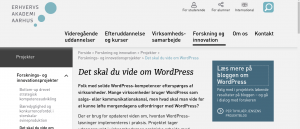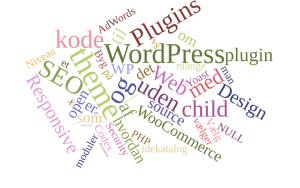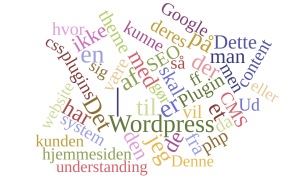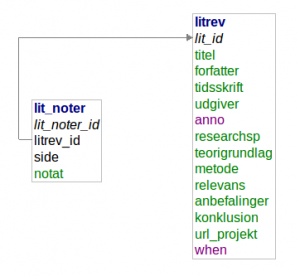
If you want to try the new version of WordPress the Beta Tester Plugin is a must. However, don’t run it on a production server! After all a tester isn’t stable.

So the project is launched on our webpage ( http://eaaa.dk ). For now the text is only available in danish. A very short resume:
The business needs people with solid WordPress knowledge. Many businesses use WordPress as their prime sales or communication channel – what kind of knowledge do you need in order to meet tomorrow’s challenges with WordPress?
During the next weeks I’ll begin interviewing WordPress professionals and users. In general the idea is to explore the knowledge levels needed for WordPress professionals.
The title of this research project is: “What You Should Know About WordPress”. Below the statement you’ll find a question:
– What should you know about WordPress?
Many students have to work with WordPress during internships. The students are connected to supervisors from the business academy. They are also connected to different mentors in the business.
So each interview with a student could perhaps spawn into two or three new interviews.
By reflecting the hierarchical organizational structures of universities, the LMS built on a strict top-down approach, giving absolute administrative control to technical specialists in an IT-department, while giving less control to the teachers.
(Vladimir Torberg et al. “Sustaining Teacher Control in a Blog-Based Personal Learning Evironment” 2013)
This quote is spot on. To this day I have never seen a LMS that was loved by the teachers and students. The author suggests that the internal structures of LMSs reflect the hirarchy of the organization.

The word-clouds are alchemic destillations of my literature review so far. I saved 500+ quotes from student reports and academic papers about WordPress in a MySQL database. I printed out all the quotes in one long string from the database.
The actual word-clouds are made by a Chrome plugin. The clouds are a data visualizations. They will show the frequency of the words that WordPress professionals or scholars use. Size matters here. Big words are words that occur often in my notes.
The first cloud is made by my sum up of the notes from the reports. After reading the text I summed up the basic ideas. The first cloud is a visualization of my interpretation of the research texts.
At this point of the literature review the works of students dominate. The words come from my hermeneutic coding or sum up of internship reports, final reports, BA thesises and around 10 scientific articles on WordPress.
A cloud like this is an answer to my research question:
What should you know about WordPress?
Here the answer is:
The next word-cloud is the result of all the notes and quotations from these texts.

Since most of the reports are in danish the clouds will have many danish words. However most words about the WordPress craft are in english.
The second wordcloud is very similar to the first one. However we get options like:
So these clouds are visual answers to my research question.
If I remove the academic papers, the word-cloud looks like the one below. I have removed a long string of common words in order to get a WordPress-specific cloud. Else I’d get a cloud with tons on and, or, when and what not. Below is the cloud.

The cloud does not add much new stuff. However there is more emphasis on the customers (da. “kunden”). The prominent words are:
It’s strange to see that PHP, CSS and Jquery does not play a prominent role here. Here I think that the data visualization gives a wrong impression.
During the initial phases of my research project I asumed that a WordPress professional would be nerdy. Stuff like advanced CSS, Jquery, MySQL, SQL, ER-diagrams, preprocessors, Gulp, Nodejs and so on should dominate the picture.
These word clouds demonstrate, that my initial hypothesis was not precise.
In fact many WordPress professionals build custom made solutions without much code at all. Some professionals use one theme for all. What you can achieve with WordPress without code is important.
On the other hand there is a huge difference between haute couture and pret a porter.
Perhaps the real secret behind the success of WordPress is the ease of use. Using WordPress is not that different from the feeling of using a word processor such as Libre Office or MS Word.
The word-clouds are a kind of sum up of my literature review so far. During the next phase I will focus on interviews with WordPress practitioners and professionals. Can they recognize the vision in the clouds?
That’s what I’ll investigate during the next spin of the hermeneutic circle.
The word-clouds visualize the hermeneutic codes as stored in my database with notes and quotes. What they say is interesting – but we should not forget, that the clouds only gives a fragment of the picture.
Perhaps important methods are only mentioned once. Or even not at all. In that case such topics will not be visible in the word-clouds. As the book of wisdom Tao Teh King states: we get usefullness from what is not there.
Thirty spokes share the wheel’s hub;
It is the center hole that makes it useful.
Shape clay into a vessel;
It is the space within that makes it useful.
Cut doors and windows for a room;
It is the holes which make it useful.
Therefore benefit comes from what is there;
Usefulness from what is not there. (Translated by Gia Fu Feng)
Source: Drive WordCloud by Google (Plugin for Chrome).

Now I have read all the available WordPress cases on the BAAA server. I have followed the development of the Twentyseventeen core theme. In both cases the reading should be followed by interviews.
And then the next logical step is to select the most relevant cases. Each case is surrounded by a small group of stakeholders, such as:
Twentyseventeen is perhaps the most important case. Because here you can see the interaction between Automattic and the open source community. Twentyseventeen is integrated in the WordPress-core, therefore it is not a trivial matter.
By now I can see, that the Multimedia studens work hard with tweaking themes and child themes. Some of them even write their responsive themes from scratch.
In the end I hope, that the research will show:
In the end these answers will form the answer to my initial quest: “What You Should Know About WordPress”.
Now the Twentyseventeen theme will merge into the WordPress core. The developers worked on Github. The open source community is ready to present the new WordPress core theme. Here is David A. Kennedy’s official proposal.
As usual, a default theme couldn’t happen without the community. This year, Twenty Seventeen has benefited from 57 amazing contributors so far (up from 38 at this point last year). (Kennedy’s proposal op.cit.)
My sources are saved in a MySQL database. I’d like to write my text in LaTeX via LyX. I cannot use the database directly in my reports. So I need a compiler, that will convert my data to a format, that LyX & friends can handle.
Therefore I have made a little compiler in Python. I’ll use the Python mysql.connector. Ubuntu has the relevant packages in the repos.
The compiler will format an ascii-file according to the Bibtex format:
@book{wp_12,
author=”Raielo, Eike J.”,
publisher=”Hovedopgave, EAAA”,
title=”Development of WordPress plugin Dreamgrow Scroll Triggered Box”,
year=2016
}
Here is the bibtex compiler:
# kompile to the bibtex format
for row in cursor:
print "@book{wp_" + str(row[3]) + ","
print "author=\"" + row[0] + "\","
print "publisher=\"" + row[4] + "\","
print "title=\"" + row[1] + "\","
print "year=" + str(row[2])
print "}"
print ""
A book should have a unique name. The unique id from the table could be used here. The book will get an id like wp_123 in the line:
print “@book{wp_” + str(row[3]) + “,”
Save the Pyhon file as myBibliography.py. Create the bibliography as below:
# python myBibliography.py > bibliography.bib
The complete code is available on Githup.
International characters may look odd. A workaround is to open the .bib file in KBibTex and save it again. Perhaps it’s not elegant, but it works all right. KBibTex will add special characters. My name will demonstrate what happens to Scandinavian characters:
@book{wp_3,
author = “Jensen, Per Thykj{\ae}r”,
publisher = “Per Thykj{\ae}r Jensen”,
title = “{Research-wordpress.dk}”,
year = 2016
}
Literature review is a craft that is closely related to database design. If you work with research one of the first steps is to design your research database.
In “How to Write a Thesis” Umberto Eco once wrote that the researcher should work with files. He suggested that the researcher should write notes on cardboard sheets and save them in a directory for reference.
So they worked in 1977. Today the research professional should use a well designed database a the primary literature review tool.
Don’t expect to find a database or some software app that suits your literature review. Frascati projects are unique. If not – how could they provide new knowledge?
So before you begin to work, you’ll have to design a database for your literature review. This paper gives suggestions to database design and the relation between the arts and the database.
First of all your database should reflect your general method.
Basicly “What you should know about WordPress” is a systematic collection selected practiconers experiences with WordPress in the form of texts and conversations. By doing so I hope to be able to understand the craft.

Coding played an important part in the grounded theory approach to operative research introduced by Glacer and Strauss in 1967. Here coding refers to “the process of breaking down, examining, comparing, conceptualizing and categorizing data.” [Kvale et al 2009: 202]
Kvale et al. is all about interviews in research. Principles from the philosophy of science apply to this project. “What you should know about WordPress” collects data about real WordPress usage. My primary sources are reports.
I see the final reports and internship reporst as “reflection on practise”. Of course inspired by the philosophy of Donald Schön. The reports are “utterances”. During the study they are “coded” and saved in my database.
From the reports I collect data, like:
The data is boiled down to keywords, or “code” according to Kvale et al. I doubt that a scholar from the computer science would say code here. Probably they would talk about data. That is as soon as the stuff is made persistent in the database.
(data defined) “… information, most commonly in the form of a
series of binary digits, stored on a physical storage
medium for manipulation by a computer program. It is
contrasted with the program which is a series of
instructions used by the central processing unit of a
computer to manipulate the data.” [The Collaborative International Dictionary of English v.0.48]
In 1999 Lev Manovich claimed that the database mimics the world as an unordered list:
“As a cultural form, database represents the world as a list of items and it refuses to order this list. In contrast, a narrative creates a cause-and-effect trajectory of seemingly unordered items (events). Therefore, database and narrative are natural enemies. Competing for the same territory of human culture, each claims an exclusive right to make meaning out of the world.” [Manovich: “The Database as a Symbolic Form” 1999]
I don’t agree with this definition. A database is ordered. You’ll even use a language in order to communicate with it. In fact MySQL database is a collection of ordered lists.
These lists are connected via keys. You query the database via a language. Perhaps the database and the narratives are more friends than enenies.
And yes – the data will come to the database in an unordered way. But the coding and the logic of the database schema will produce a narrative. You can even interpret the results. And so we enter the elusian fields of the hermeneutic arts.
I have designed my database in order to have a systematic appoach to my notes. In this way the study of the practical cases is “coded” in a Glacer-and-Straussian manner.
The database scheme is simple and powerfull at the same time. On the surface sources and notes are combined. But by SQL it’s possible to find informations about any keywords in the sources for my data.

In this way the research database is a hermeneutic circle:
“The first canon involves the continuous back-and-forth process between parts and the whole, which follows from the hermeneutical circle. Starting with an often vague and intuitive understanding of the text as a whole, its different parts are interpreted, and out of these interpretations the parts are again related to the totality, and so on.” [ Source: Stanford Encyclopedia of Philosophy : Hans Georg Gadamer ]
The process has a beginning. I guess that there is no end to adding texts to the database. The literature review will go on from the beginning to the end of this project.
In fact this database is my hermeneutic circle.
In order to conduct a literature review you’ll need a literature review database. The database schema (or design) should reflect your research method. So there’s a connection between your philosophy of science paradigm and the kind of database you’ll need.
In this article I have shown a database that was designed for a project in the arts that draws on the hermeneutic tradition. Your project problably needs another kind of database.
Eco, Umberto: “How to Write a Thesis” (1977)
Kvale et al.: “Interviews – Learning the Craft of Qualitative Research Interviewing” (2009)
Today’s question from a student: “How do we move a multisite WP?”. The Codex has this answer.
The database comes in handy by now. My pool of papers rose from around 10 to 40. In the morning I read two reports in about three hours. Most of them are in .pdf – so I can search for keywords and find relevant quotes relatively quickly.
I guess that it will be possible to read around 5 – 6 reports a day. So in two weeks or so I’ll have a nice pool of data about practical WordPress usage.
Occurence of the word x in reports at Office365 @BAAA (visited: Oct. 10th 2016)
Take these numbers with a grain of salt. As far as I can see the system counts the occurrence of the word – not the number of reports. A dedicated fan might write WordPress many, many times …
We use cookies - more information
Multimusen.dk will set a few cookies from Doubleclick, Google and the Social Media plugins they ay set some cookies. Some of my pages use APIs - such as YouTube, LinkedIn, Google Fonts, Google Maps, Mapbox, Spotify, Jetpack, Twitter, Facebook &c.. Such plugins may set the odd cookie.